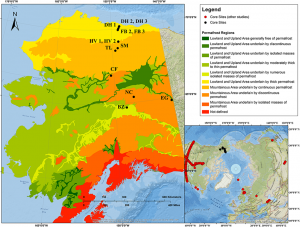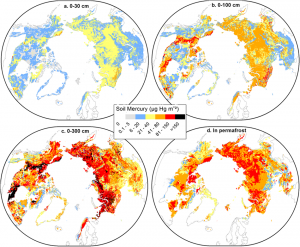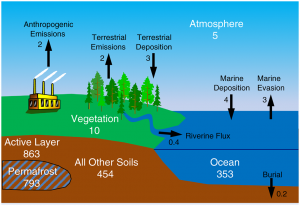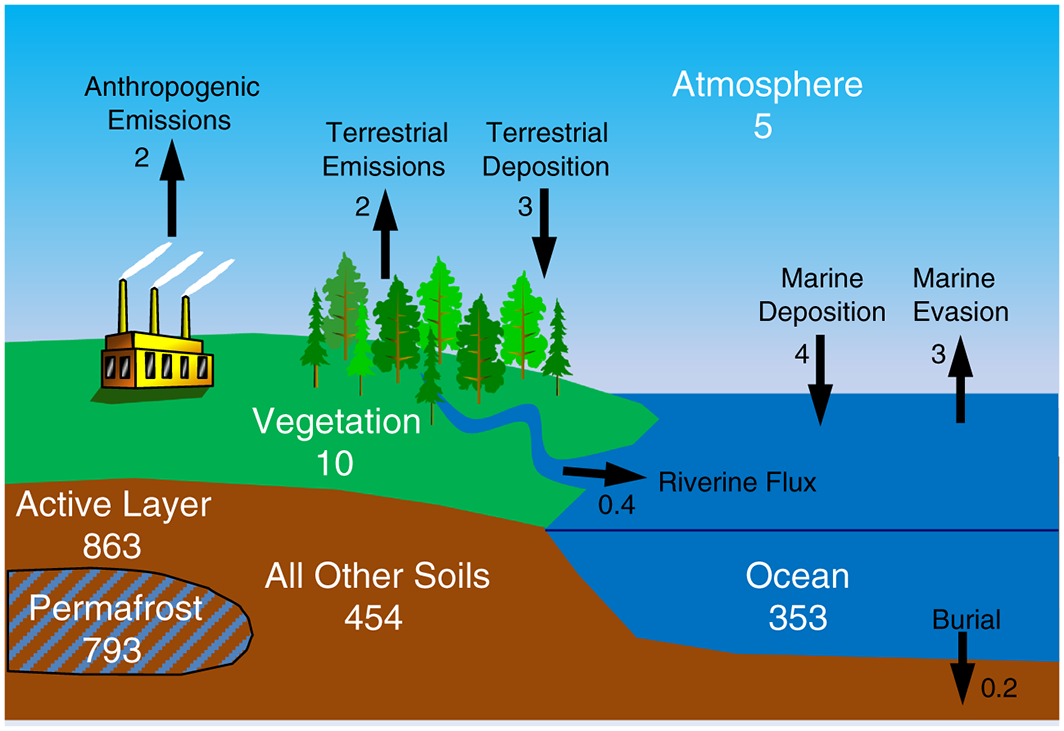Article: Schuster et al. Permafrost Stores a Globally Significant Amount of Mercury, Geophysical Research Letters, 45, doi: 10.1002/2017GL075571, 2018
Unexpected consequences of our actions
We all know we are adding way too much CO2, and other greenhouse gases, to the Earth system and the system just can’t keep up. As a result, the Earth is warming, the ice is melting, and the ocean is becoming more acidic. But in what ways will the Earth change that we haven’t accounted for? Climate change is a chain reaction that will lead to lots of changes we are aware of and some we will be surprised by.
Scientists are concerned about the unforeseen consequences of a warming climate. Research is underway to investigate some of these unexpected secondary changes. One of these is what will be released when the permafrost melts. Permafrost is soil that stays at or below freezing for at least 2 consecutive years. There is a developing between permafrost melting and methane release which would warm the Earth more (a positive feedback) but what else? Scientists are realizing that mercury will be released but it is unclear how much. Researchers in this study argued that a substantial amount of mercury will be released and permafrost, and the soil above it, is currently the dominant mercury storage on Earth. Mercury is a toxic chemical that accumulates in living things faster than it can be released. It also increases with each level up the food chain. When pregnant women and young children eat food with high levels of mercury (such as tuna), it is likely the child will develop neurological issues (e.g. decline in fine motor skills).
How does mercury get to the high latitudes?
Mercury (Hg) has both natural and anthropogenic sources. Some major natural sources include boreal forest fires, volcanoes, and deposition from summertime ozone depletion. All of these will have a wide range of spatial and temporal releases. For example, a volcano will release a significant amount of mercury but it isn’t a consistent release. Our anthropogenic emissions (e.g. coal power plants and mining) release mercury into the water and atmosphere which also end up in the high latitudes.
Burying mercury

Mercury enters plants either through the root system or by dry deposition onto leaves. The mercury attaches to organic molecules in the plant replacing spots where nutrients (e.g. iron or magnesium) would go. Normally, what happens next is as the plant decays microbes eat up the organic matter and release the mercury in the soil. Sedimentation will slowly move this decaying organic matter deeper and deeper. What changes in the permafrost environment is the deeper soil will freeze into permafrost. This frozen soil essentially traps the mercury inside it because the microbial activity slows down to basically zero. On human time scales, this is considered a permanent sink for mercury. Unfortunately, models are predicting a 30-99% reduction in Northern Hemisphere permafrost by 2100. This study estimated the relationship between mercury in permafrost to soil organic carbon based on measurements and calculated how much mercury could be released from permafrost melting.
Methods
Researchers collected cores from 13 permafrost sites in Alaska (Figure 1). They measured the active layer depth (the non-frozen soil on top of permafrost) and cored permafrost below that. They measured the sediment total mercury, bulk density (tells you about mineral make-up), soil organic carbon, and the delta C-14 from these cores. The C-14 was used to date the soil. The sediment total mercury and soil organic carbon were used to calculate the mercury to carbon ratio. This ratio was used to calculate the soil mercury stored in the Northern Hemisphere.
What did they find?
The median sediment total mercury was 43+3- nanogram (ng) mercury per gram of soil. The median mercury to carbon ratio was 1.6 + 0.9 microgram (ug) mercury per gram of carbon. These results were fairly consistent with previously published results within the reported error. Some of the differences came from variability in sample site. One potential reason for variability is anthropogenic contamination. Despite the differences in sample site, the observed ratio of mercury to carbon was fairly consistent with the previous literature (published median is 2.0 + 1.9). Researchers found that the ratio was independent of site location, soil type, depth, and age. This is useful when calculating the total mercury stored in sites all over the Northern Hemisphere.

Where is all the mercury?

After measuring the permafrost mercury to carbon ratio and confirming it is similar to previously reported literature work, these researchers could estimate how much mercury was stored in the Northern Hemisphere and where. Figure 2 shows maps of mercury in four soil layers for the Northern Hemisphere permafrost zone. Figure 2c shows all the mercury bound to organic matter in the permafrost and soil layer above it. Figure 2d represents the permafrost trapped mercury. The differences in mercury within each map reflect the different soil types and amount of organic matter.
Researchers in this study also used their results, along with previously published work, to estimate where the mercury is stored in the modern mercury cycle (Figure 3). They estimated that the permafrost layer stores 32% of the current global mercury. These researchers also found that the active layer, the layer of soil above the permafrost, is the largest mercury storage on Earth! If models are correct and the permafrost melts, the mercury turnover time will change from ~14,000 years to ~70 years. We don’t know yet what impact this release of mercury will have on the environment. We do know, however, that mercury consumption can damage your brain and central nervous system.
I am a PhD candidate at the Graduate School of Oceanography at the University of Rhode Island. I am an atmospheric chemist studying organic acids in the troposphere to better understand their role in ozone processing. I flew on a Gulfstream V and a C-130 all in the name of science!

